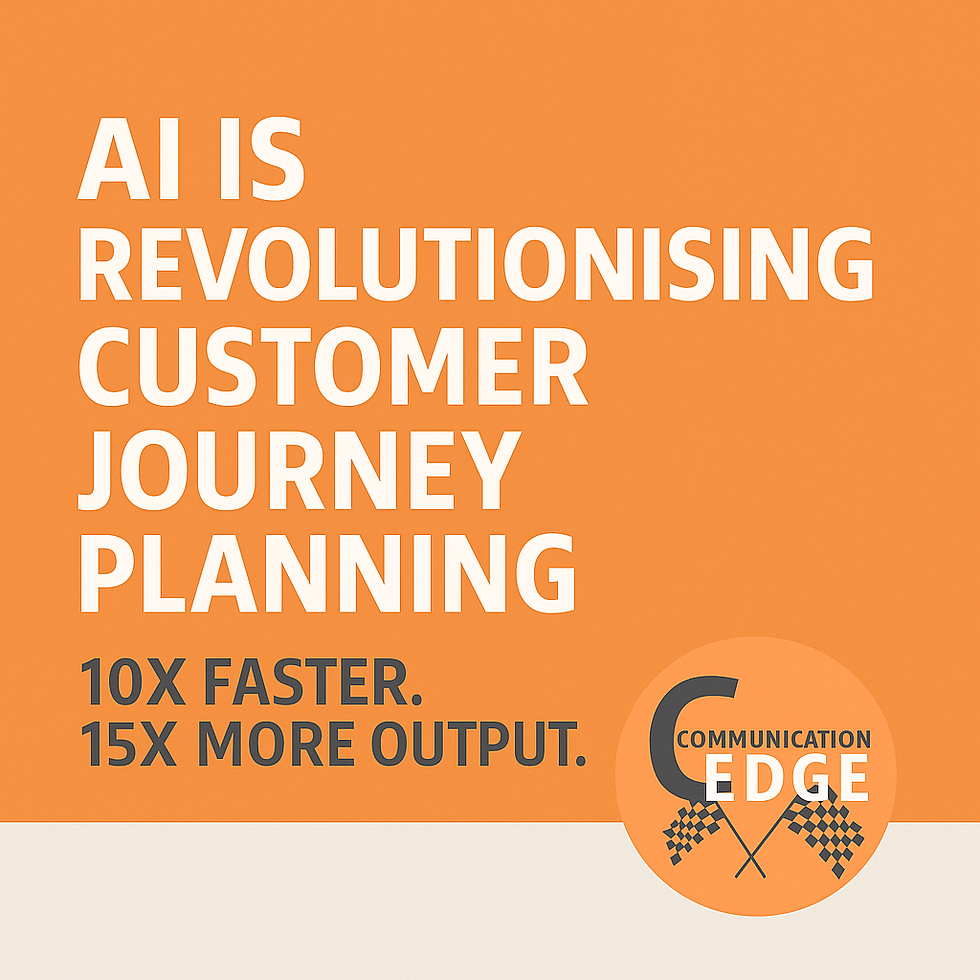How AI has cut content delivery times
- Simon Hunt
- Sep 19
- 7 min read
Updated: Oct 21

For decades, marketers have chased the holy grail of creating a perfect customer journey: one that smoothly guides a prospect from awareness, through consideration, to purchase and long-term loyalty.
The concept isn’t new — mapping touch points, identifying pain points, and designing interventions to reduce friction has always been central to marketing strategy.
The challenge has been execution. Traditional customer journey mapping was slow, resource-intensive, and often based on assumptions rather than hard evidence.
Insights from surveys or focus groups were valuable but limited in scope. Worse still, customer behaviours changed faster than most marketers could keep up with.
Today, Artificial Intelligence (AI) has transformed that picture. By analysing huge data sets, predicting behaviour, and automating execution, AI now enables CMOs and marketing teams to design customer journeys with greater speed, accuracy, and effectiveness than ever before.
This shift is not just incremental — it’s exponential. Marketers are preparing plans 10X faster, and even junior marketing interns can now deliver 15X more output at higher quality levels.
Let’s break down how AI has reshaped the discipline.

From Guesswork to Data-Driven Maps
In the past, journey mapping meant brainstorming sessions, sticky notes on whiteboards, and customer interviews.
While creative, the process was subjective. Pain points were assumed, not always validated, and touch points were often missed.
AI removes the guesswork.
Platforms like HubSpot, Salesforce Einstein, and Adobe
Experience Cloud ingest data from CRM systems, web analytics, call centres, and even social media. They stitch these sources together into a unified journey view:
Awareness triggers: what content, ads, or keywords customers first engaged with.
Consideration behaviour: pages browsed, downloads requested, questions asked in chat.
Decision signals: repeated visits to pricing pages, demo requests, cart behaviour.
Post-purchase patterns: support tickets, NPS surveys, repeat orders.
Instead of relying on a persona exercise once a year, AI delivers dynamic, evidence-based maps that update in real time.

Identifying Pain Points with Precision - AI cutting content delivery times
One of the most powerful applications of AI is pinpointing where customers get stuck.
Tools like Hotjar, FullStory, and Google Analytics (powered by machine learning) highlight bottlenecks across the journey.
Form abandonment: AI can reveal that 65% of prospects drop off at the payment form due to mobile design flaws.
Support gaps: natural language processing (NLP) analyses support tickets and chatbot transcripts to uncover recurring frustrations.
Content mismatches: predictive analytics shows when prospects bounce because they don’t find content aligned to their search intent.
For CMOs, this is gold. Instead of relying on anecdotal sales complaints, they can show the board precise, data-backed pain points — and allocate budget where it matters most.
Addressing Concerns at Scale
Knowing the pain points is half the battle. Addressing them effectively is where AI creates real conversion lift.
AI-driven platforms now automatically test solutions across channels:
Dynamic website content: Personalised banners, CTAs, or pricing offers adapt instantly to visitor profiles.
AI-powered chat: Tools like Drift or Intercom answer objections on the spot, 24/7.
Content generation: Generative AI creates tailored blog posts, FAQs, or nurture emails that directly resolve specific concerns surfaced in the journey analysis.
Instead of “one-size-fits-all” campaigns, each touchpoint becomes responsive and personalised. That leads to higher engagement, more trust, and ultimately, more conversions.

10X Faster Journey Planning
For CMOs, the acceleration AI brings cannot be overstated. What once took six weeks of workshops, data crunching, and design iterations can now be done in days.
Automated research: AI tools scan competitor journeys, keyword gaps, and intent data in minutes.
Pre-built models: Machine learning models generate journey templates tailored to specific industries (e.g., SaaS vs. retail vs. B2B services).
Predictive outcomes: CMOs can test scenarios — “what happens if we reduce friction in checkout by 20%?” — and get instant ROI forecasts.
The result: CMOs spend less time on diagnostics and more time on strategic decision-making and execution.

Empowering Interns to Produce 15X More Output
Perhaps the most unexpected benefit of AI-driven journey planning is how it transforms team productivity, particularly for early-career marketers.
Traditionally, interns and junior staff were given repetitive, manual tasks — gathering data, drafting generic content, or creating basic reports. Output was limited by their experience and the steep learning curve.
AI changes the game:
AI writing assistants (Jasper, Writesonic, ChatGPT) help interns produce high-quality, on-brand content in minutes.
Automated dashboards (Looker Studio, Power BI) replace manual reporting.
Content optimisation tools ensure every article or ad is search-ready and customer-focused.
With the right coaching, a fractional CMO or marketing manager can now brief interns once, then oversee a flow of 15X more content, assets, and insights — all aligned to the journey map. Productivity skyrockets without sacrificing quality.
Effectively AI cutting content delivery times.
The Hybrid Model: Human Creativity + AI Precision
It’s tempting to think AI makes human input redundant, but the opposite is true. AI handles the heavy lifting — data processing, pattern recognition, content drafting.
Humans bring creativity, empathy, and strategic judgement.
The best-performing companies use AI as a co-pilot, not a replacement:
Marketers interpret AI insights and decide which levers to pull.
CMOs set the commercial objectives and ensure alignment with revenue goals.
Interns use AI tools to create outputs, guided by senior leaders on tone, positioning, and context.
This hybrid model produces results no whiteboard workshop or agency pitch could ever match.
Why This Matters to CMOs and MDs
For leadership teams, AI-driven customer journey planning solves three critical business challenges:
Accountability: Journey plans are now measurable, linked to ROI, and board-ready.
Efficiency: Senior marketers spend less time gathering data and more time driving strategy.
Scalability: SMEs and mid-caps can now run customer journeys at enterprise-level sophistication without enterprise-level budgets.
Practical Example: The 90-Day Plan
Here’s how a CMO might now structure a 90-day AI-powered customer journey programme:
Days 0–30 – Diagnose
Use AI tools to map the full funnel (awareness → consideration → decision).
Identify pain points via analytics, heat-maps, and NLP on support queries.
Build an evidence-backed journey map.
Days 31–60 – Design & Test
Deploy AI-driven personalisation on key web pages.
Launch conversational AI to answer FAQs and capture leads.
Brief interns to generate 30+ high-quality blogs, FAQs, and social posts aligned to identified pain points.
Days 61–90 – Optimise & Scale
Analyse conversion lift via AI dashboards.
Double down on top-performing channels and content.
Introduce predictive lead scoring to prioritise prospects.
The board gets not just a plan, but measurable progress within three months.

Conclusion: A New Era of Journey Mapping
AI has fundamentally changed the way marketers plan, execute, and optimise customer journeys. What once took months now takes days.
What once relied on guesswork now runs on evidence. What once required large teams now thrives with a lean human + AI model.
For CMOs, the implications are clear:
Customer journey planning can be 10X faster.
Junior marketers, empowered by AI, can deliver 15X more output at higher quality.
Pain points can be identified and addressed with scientific precision.
The end result isn’t just smoother journeys — it’s growth. More leads, better conversions, lower costs, and stronger lifetime value.
For SMEs and mid-cap businesses especially, this is transformative. You no longer need enterprise budgets or massive teams to compete. With AI, you can deliver customer journeys that convert — and outmanoeuvre competitors still relying on outdated playbooks.
The future of marketing belongs to those who embrace AI not as a shiny tool, but as a core capability.
The question for CMOs and MDs is no longer if you’ll use AI in customer journey planning — it’s how fast you can integrate it before your competitors pull ahead.
FAQs for Cutting Content delivery times with AI for SMB Marketing
How does AI reduce content delivery time for marketing teams?
AI automates repetitive tasks like research, drafting, formatting, and optimisation—compressing multi-day workflows into minutes. Marketers can focus on creative direction rather than manual production.
Essentially the planning,brief preparation shortens from month to days, at least 10X faster.
Which AI tools are most effective for speeding up content creation?
Tools such as ChatGPT, Jasper, Copy.ai, and Grammarly accelerate ideation, writing, and editing, while SurferSEO and Frase optimise posts for search intent and readability.
A Miro Boards for Planning and Managing content delivery and articulating customer journeys.
Can AI help maintain quality while producing content faster?
Yes. When used with clear briefs, brand tone rules, and human editing, AI improves consistency and accuracy without sacrificing quality or originality.
Essentially use it for structuring content, originality still wins!
How does AI shorten the approval and revision process?
Generative models pre-format drafts to meet brand guidelines, drastically reducing stakeholder review cycles and rework time.
AI can analyse pages and with tools like SEranking increase content scores/rank positions. Less content finessed to rank is always better than volume low quality content.
Does AI assist in content distribution as well as creation?
Absolutely. AI-driven platforms schedule and tailor posts across multiple channels, measure engagement, and optimise timing for maximum reach.
What measurable time savings can businesses expect from AI content workflows?
Most SMEs using AI-assisted tools report a 50–80% reduction in turnaround time from concept to publication.
How does AI improve collaboration between marketing, design, and sales teams?Centralised AI systems (like HubSpot AI or Notion AI) streamline feedback loops, content tagging, and shared asset management—reducing version control issues.
Is AI suitable for long-form or technical content?
Yes, with the right prompts and subject expertise. AI drafts frameworks and outlines, while human editors refine details, citations, and tone for technical accuracy.
And that's the key - the right prompts someone has to know what to ask for and the deep marketing subtleties.
What are the risks of over-relying on AI for content creation?
Risks include generic output, factual inaccuracies, and brand dilution. Regular human oversight, quality assurance, and compliance checks are critical.
How can SMEs start integrating AI into their content workflow effectively?
Begin with low-risk automation (headlines, outlines, SEO suggestions), train AI on existing tone-of-voice documents, and measure delivery speed improvements through analytics dashboards.



Comments